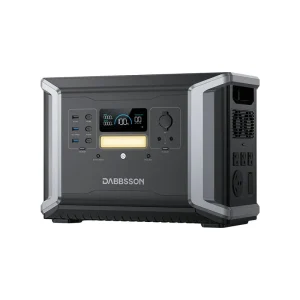Portable Power Station Efficient? Portable Power Stations are set up to delivery AC electricity whenever it is needed while having efficiency rates somewhere between 80% to 90% depending on the model and battery type. These devices have a high capacity (usually ≥500 mAh) lithium-ion or lithium-iron-phosphate (LiFePO4) battery that can keep more than 80% charge after 500 charging cycles, which is about 3 to 5 years of using the batteries in regular usage premises. Efficiency is mostly function of inverter quality, then power output and battery size, that accumulatively affect how well can these stations convert stored energy into usuable AC or DC power.
Like a regular mini power station with a capacity of 500 watt-hours (Wh), it may charge your Smartphone up to 50 times or power a small 60W tool for about 8 hours, making it useful in both general and emergency situations. Models with larger capacities, like the Dabbsson DBS2300, have over 2000 Wh and can keep refrigerators or even a CPAP machine running for up to 20 hours. The bigger units also have more capacity as well as larger inverter efficiency, up to a 90% energy conversion rate when getting power for its devices via AC.
Likewise, efficiency is also a virtue when it comes to recharging – With many portable power station usable also for solar and support fast-charge through an AC outlet. On a sunny day, solar power is between 60-80% efficient at turning sunlight to electrical output (depending on the quality of the crystalline photovoltaic material) so devices can recharge back up to full capacity from a good deep depletion overnight in 6-8 hours in optimal conditions. Even better is that USB-C PD-compatible models paired with larger fast chargers can cut AC outlet recharging times to 2-3 hours, which are practically off-grid campsite-ready.

From being a sustainable option to traditional fuel-based generators, portable power station come off as more cost-effective. And, Instead of spending up to $30 or more each time you need to fill up a tank of gas… Typically saving consumers upwards of $500+ every year on fuel just for normal use. In addition to financial savings, they are entirely emissions-free —making them a key component for the environmentally conscious consumer or outdoor aficionado looking to minimize their impact.
Its portability and durability also contribute to the energy efficiency. They are convenient to transport as their sizes range and are pretty compact with small ones weighing an average 10-20 pounds. Rugged designs are safeguarded against water and impact, the temperature range may be between -10°C, and 40° Celsius that provides painless use in different environments. Their increasing popularity is due to the fact that, they are portable, consume very less energy and save on cost making it a prudent choice for both recreational purposes as well as in case of emergencies.